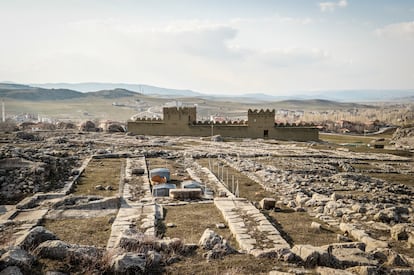Extreme drought ended one of the ancient world’s greatest empires
Wood from the tomb of King Midas’ father shows how a rainfall shortage and widespread famine could have wiped out the Hittite civilization

The steadily shrinking tree rings of lumber used in a Phrygian tomb have helped a group of scientists estimate the date of the collapse of the Hittite empire: 3,219 years ago, that summer’s grain harvest was terrible, just as bad as the previous two had been. The bellicose civilization depended on grain and couldn’t collect taxes from farmers or feed its army. Famine became widespread, and the state eventually broke down. It’s not the first time climate impacts have been blamed for the end of Hatti, a civilization rivaling the Egypt of Ramses II. But never before has it been dated so precisely. The study that reached this conclusion says what happened to the Hittites can teach us something about the dangers of climate change.
The Hittite or Hatti Empire emerged about 3,670 years ago (around 1650 BC) in central Anatolia, which includes much of modern-day Turkey. For the next five centuries, the Hittites were one of the major powers of the ancient world, along with the Assyrian, Babylonian and Egyptian empires. But around 1200 BC, the capital city of Hattusa was abandoned. When archaeologists unearthed the city’s remains, they found no evidence of an attack or other cataclysm, such as a plague or a revolt. What made the Hittites abandon their capital, which was also home to their gods?
For decades, the region’s instability and non-stop warfare were blamed for the demise of empires. The area has been called the cradle of civilization due to the many advances in agriculture, architecture, writing and international trade that emerged there. Some blame a mysterious seafaring people who ravaged the entire region three millennia ago. Climate science has added one more factor into the mix — the progressive cooling of this part of the world. There was a mini-ice age, according to many historians.
Sturt Manning, an archaeologist with Cornell University in New York, argues that long-term, piecemeal changes “do not usually precipitate collapse because people and societies can usually adapt in a variety of ways.” However, he says, “several consecutive years of unexpected crises can undermine many human societies dependent on agriculture and animal husbandry.” In a recent paper published in Nature, Manning and his colleagues say that is what happened to the Hittites. Manning is the director of Cornell University’s tree ring lab. The rings that form on trunks as a tree grows are magnificent timepieces. Dendrochronology is the scientific method of dating tree rings to the exact year they were formed. But they also function as meteorologists of antiquity. The thickness of the tree ring reveals whether the growth year was wet or dry.
Years ago, a tomb carved out of a mountainside was discovered a few miles from Ankara, the capital of Turkey. Carbon dating indicated it was a 3,000-year-old Phrygian burial chamber. Perhaps it belonged to King Midas, but more likely, it held his father. The Phrygians arrived in Anatolia after the Hittite empire had already disappeared. But the wood used in the tomb is from junipers that can live up to 900 years, silent witnesses to the days of the Hatti.

Manning and his team used the latest technology to study the juniper wood and made two significant observations. “As expected, we found that annual drought episodes were relatively common, which is exactly what the Hittites anticipated and planned for.” Indeed, grain silos guarded by garrisons dotted the entire empire, which also built dams and reservoirs to preserve water for low rainfall seasons. “But very occasionally – about once every two centuries – there were instances of several severely dry years, probably drought. This only happened once — between 1198-1996 BC — around the time the Hittite civilization disappeared (1200 BC),” said Manning.
Wheat needs a certain amount of rainfall to thrive, especially in the spring. Manning does not have rainfall data from the Hittite period, but he and his team were able to infer that grain crops failed during those three years of drought. The scientists used 20th-century data from a weather station near ancient Hattusa and studied the rings of young juniper trees. They were able to associate crop failure episodes with the rings’ thickness and determine the minimum thickness needed to maintain a grain crop. The juniper ring thickness during those three years of drought did not reach the minimum. “We can’t determine the precise volume of rain at that time, but we can guess that it was probably around or below [the amount needed for the grain crop],” said Manning.
Raúl Sánchez-Salguero is a dendrochronologist at Pablo de Olavide University in Seville. He applauds the study’s precise dating of such a distant event. “They also substantiated their ring dating results with another technique that examines the physiology of the plants,” said Sánchez-Salguero. For each ring, there is a ratio between two isotopes (variations of the same chemical element). In this case, it’s the ratio between carbon-13 (rarer) and carbon-12. “In dry years, leaves close their stomata to minimize evapotranspiration and avoid stress. That leads to less growth, which is reflected in the tightness of the ring, but also in the ratio of both carbons,” said Sánchez-Salguero. The carbon-13-to-carbon-12 ratio peaked during those three years of drought.
Archaeologist and historian Eric Cline, a George Washington University professor, says: “Drought was only one of the many problems that the Hittites and other peoples had to face.” The author of 1177 BC: The Year Civilization Collapsed (2021) adds, “there was a cacophony of catastrophes that led not only to the collapse of the Hittite empire but also to the collapse of other powers and destroyed the international trade network that linked them all together.” A few decades later, the Mycenaean civilization fell, and the Assyrian, Babylonian and Egyptian empires experienced such difficult times that the era is known as the first Dark Age.
Cline’s book describes several factors that made that era so convulsive. “They include climate change, which led to droughts, famines and migrations; earthquakes; internal invasions and rebellions; the collapse of systems; and possibly disease. They all probably contributed to the perfect storm that ended this era.” Cline is working on a follow-up book, After 1177 BC: The Survival of Civilizations. “Of all these factors, I agree that drought was probably the main driving force behind many of the problems that Late Bronze Age societies faced. This is why the additional data from this new study are so important.”
Not everyone agrees. David Kaniewski, a climate scientist and historian at the University of Toulouse in France, emphatically says: “Three years is nothing for grain production. The Hittite empire had grain reserves that could last for years. If the drought had lasted only three years, the Hittite empire would have continued for many more years. I think the fateful factor was a combination of drought and colder temperatures over a longer period.” Cold weather did affect the Hittites. A study by Kaniewski and other scientists estimated that temperatures around the time the Hittites abandoned Hattusa dropped by 4.1-8.6°F (2.3-4.8°C), and rainfall declined by as much as 40%.
Kaniewski agrees with Manning that climate is not the only factor. “Climate plays a role when climatic threats intersect with social vulnerability. The climate was not the trigger for the collapse of the Hittite empire or the Eastern Mediterranean crisis. Still, it played an important role by aggravating the social and political instability of the Late Bronze Age.”
Manning and his colleagues believe that the fates of the Hittites and the Assyrians centuries later (also ravaged by a mega-drought) are important lessons for current climate change. “Our societies are resilient, but they can only handle anticipated threats and challenges,” said Manning. “But the current climate change is leading us toward more challenging circumstances. Extreme weather that severely undermines agriculture and other resources (such as power grids) over a large area for more than two harvest seasons will challenge us just as it did the Hittites. Yes, we have long-distance transportation, communications and many other technological advantages. But we also have many more people, security threats, and political leaders who may not be prepared or able to adapt and cope with the crisis.”
Sign up for our weekly newsletter to get more English-language news coverage from EL PAÍS USA Edition
Tu suscripción se está usando en otro dispositivo
¿Quieres añadir otro usuario a tu suscripción?
Si continúas leyendo en este dispositivo, no se podrá leer en el otro.
FlechaTu suscripción se está usando en otro dispositivo y solo puedes acceder a EL PAÍS desde un dispositivo a la vez.
Si quieres compartir tu cuenta, cambia tu suscripción a la modalidad Premium, así podrás añadir otro usuario. Cada uno accederá con su propia cuenta de email, lo que os permitirá personalizar vuestra experiencia en EL PAÍS.
¿Tienes una suscripción de empresa? Accede aquí para contratar más cuentas.
En el caso de no saber quién está usando tu cuenta, te recomendamos cambiar tu contraseña aquí.
Si decides continuar compartiendo tu cuenta, este mensaje se mostrará en tu dispositivo y en el de la otra persona que está usando tu cuenta de forma indefinida, afectando a tu experiencia de lectura. Puedes consultar aquí los términos y condiciones de la suscripción digital.
More information
Últimas noticias
Welcome to the post-religion era: The idea of Christianity as the absolute truth has become obsolete
‘I thought you would like it’: The risky sexual practice popularized by TV shows and TikTok
The digitalization of tourism: ‘They promise experiences and gave us the worst possible one’
Mexican peso defies uncertainty with forecasts of a new period of stability in 2026
Most viewed
- Sinaloa Cartel war is taking its toll on Los Chapitos
- Reinhard Genzel, Nobel laureate in physics: ‘One-minute videos will never give you the truth’
- Oona Chaplin: ‘I told James Cameron that I was living in a treehouse and starting a permaculture project with a friend’
- Why the price of coffee has skyrocketed: from Brazilian plantations to specialty coffee houses
- Silver prices are going crazy: This is what’s fueling the rally











































